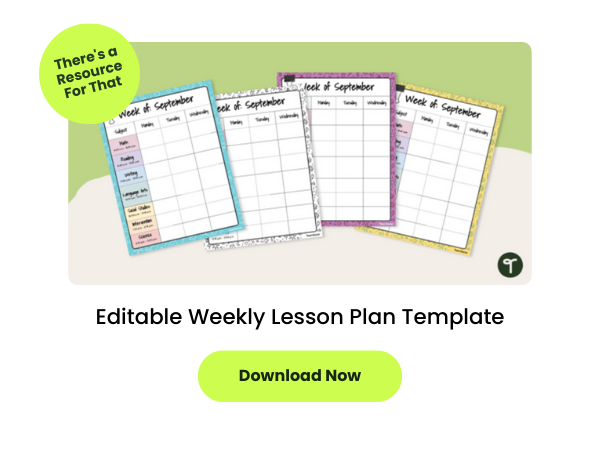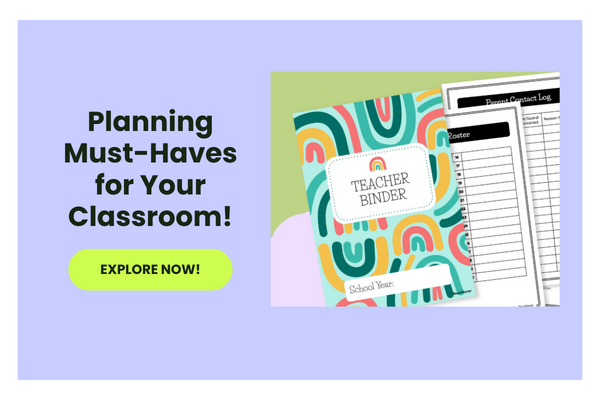Wondering how to write a lesson plan that will set you and your students up for success? It’s an important skill for teachers, and in many school it’s even mandatory. But sitting down to write your own lesson plan can feel a whole lot different when you’re the sole classroom teacher than it may have back in the days of student teaching. Where do you even start? How do you create a lesson plan that’s going to engage your students and drive inquiry-based instruction? Does your plan need an objective? Are there lesson plan examples that you can follow?
Hold on! Take a breath!
The Teach Starter team (they’re the ones who create the resources teachers depend on for their lesson planning!) is made up completely of teachers who have been (or currently are) in your shoes. We know what it’s like to work in districts where planning time is minimal or non-existent, and we know just how challenging it can be to find the time to create a lesson plan. That’s why we’ve put together some of our team’s best tips for writing lesson plans that allow you to work smarter, not harder!
Wondering if you should use a lesson plan template? Looking for tips to make lesson planning less cumbersome and more useful? And for that matter, are you caught up wondering how you write a lesson plan that is aligned with standards and district curriculum expectations while also engaging your students and getting them excited about the subject matter?
We’ve covered all of that! Read on for tips from our teacher team to help you create lesson plans your administrators will love. Best of all, these are plans you’ll be able to use again and again to launch your students’ learning journeys.
- What Is a Lesson Plan?
- What Should a Lesson Plan Include?
- How to Write a Lesson Plan More Easily
- Lesson Plan Examples to Borrow From
- How Far Ahead Should You Plan Lessons?
- How Long Should It Take to Make a Lesson Plan?
- The Bottom Line
What Is a Lesson Plan?
This may seem a little obvious, but please bear with us here. Thinking about what a lesson plan actually is an important part of reframing the process. We’ve seen more than a few new teachers who are feeling stressed out about making a lesson plan, only to realize they’re overcomplicating things.
A lesson plan is essentially a road map for a particular lesson that includes what to teach, how to teach it and what learning outcomes you aim to achieve. A good plan will help you stay organized and provide a structure for your instruction for a specific class or topic.
What Should a Lesson Plan Include?
Every lesson plan looks different, just as every teacher and lesson is different. It’s important to note that some districts may have specific requirements for lesson plans that are more or less detailed.
With all that said, a basic lesson plan that you can use in the classroom outlines the lesson and provides an overview of how you will teach the topic. If an administrator or another experienced teacher were to look at the lesson plan, they should be able to pick it up and move forward with teaching your students based on that plan.
A good lesson plan might include the following:
- An objective for the lesson
- Time requirements for each aspect of the lesson
- Specific activities that will be done
- Materials that will be used
- How the lesson will be differentiated
- The method in which you will assess students’ progress
- Standards that the lesson will address
How to Write a Lesson Plan More Easily
Determine Your Objectives
Is this lesson meant to introduce new material, or will you be reviewing concepts already introduced? Identifying your objectives up front can help the writing flow.
Use a Lesson Plan Template
Every day, millions of lessons are going on in schools across the US, and every one of those teachers has had to write a lesson plan. You do not have to reinvent the wheel! Borrow from lesson plan templates that can shape your lesson planning.
Work With Your Grade Level Team
Speaking of not reinventing the wheel … the majority of districts have more than one teacher assigned to each grade level, and you’re likely focused on the same subjects too. Turn to your grade-level team — especially any teachers with more tenure in the classroom — to see if there are lesson plan examples or elements that you can share instead of starting from scratch every time.
Consider Prior Knowledge
We talk to students about activating prior knowledge all the time, and it’s important to keep in mind as you write a lesson plan. Consider what you’ve already taught and how to take students to the next step, building on their learning.
Print a rainbow teacher planner to keep your classroom on track!
Break Things Down by Time
There may be days when you find yourself looking at your blank lesson plan template with the teacher’s version of writer’s block. You’re far from alone!
In times like these, think about how much time you’ve allotted for the lesson, and reverse engineer your lesson. Let’s say your lesson hook will take you 10 minutes, and you’re planning to have students work in pairs for 10 minutes and so on … you’ve already got 20 minutes of the lesson plan complete!
Think About How Your Students Learn
Crafting a lesson plan that can be differentiated to reach every student means considering all the ways the individuals in your class learn best. Are they auditory, visual, or kinesthetic learners? Can you pair students off or create small groups, or do you have students who do best while working on their own? Also, keep students’ IEPs in mind while writing your lesson plan.
Use Teacher-Created Resources
We promise this isn’t cheating! Our teacher team has created thousands of resources — including interactive activities, unit and lesson plans, educational games and more — that can be accessed with a single subscription.
Knowing you already have resources that are aligned with the curriculum can save you significant time as you lesson plan.
Create a Lesson Ideas Parking Lot
You may have one day of the week set aside for lesson planning, but if you’re anything like us, your ideas for lessons come at the most random moments. Don’t lose those ideas; park them!
You can jot your ideas down on sticky notes that you stick to a corkboard, add them to a notes app on your phone or even record voice memos to yourself. Whatever the method is that works best for you, use these parked ideas when it’s time to plan your lessons!
Go Macro Before You Go Micro
Do you have a lot of ideas but struggle with planning individual lessons? It may be helpful to start with a broad look at the topic and skills you need to address.
From there, you can list the resources you plan to use, any activities you want to include and so on. Once you have everything listed, start pulling the pieces together to form individual lessons.
Start With a Unit Plan and Work Backward
It’s an ambitious undertaking, but you may consider creating an entire unit plan. This is similar to the lesson planning strategy above, as you can look at the big picture before breaking it down into chunks.
Be Agile
Sometimes, things just do not go as planned. The lesson you thought would be a hit left students scratching their heads, and you need to revisit the material to help your learners move forward. Don’t look at this as a failure of your lesson plan but a good learning opportunity for you about how your students learn and how you can adapt your planning to meet them where they are.
Lesson Plan Examples to Borrow From
In addition to the template above that maps out a lesson plan for you, we realize it can be helpful to look at some examples of what teachers include in their lesson plans. So we asked teachers to share their plans!
Here are some examples that stood out for us. Feel free to explore the whole list and choose elements that are right for you.
Example One
- Standards
- Learning objective
- Materials
- Warm-Up
- Whole group work
- Formative assessment
- Small group work
- Formative assessment
- Independent work
- Formative assessment
- Closing
Need simple formative assessments? Check out our teacher team’s favorite exit tickets!
Example Two
- Objective
- Do now activity
- Activities built in to gain skills toward their main task
- Main task including success criteria
- Plenary
Example Three
- Prior learning
- Topic
- Objectives
- Materials and resources
- Procedures and activities
How Far Ahead Should You Plan Lessons?
How far ahead you should plan your lessons will depend on a few factors, including the requirements in your district and your personal planning style. Lesson plans can be designed to cover just one day’s lessons or even a week’s lessons. You may also decide that your lesson plan should cover an entire unit or a specific content area.
What kind of lesson plan you’re writing will likewise dictate how far in advance it needs to be drafted. After all, you can’t create a weekly lesson plan when half the week has already gone by!
How Long Should It Take to Make a Lesson Plan?
While there is no hard and fast rule regarding how long it should take to make a lesson plan, it’s important to know that most teachers get faster as they become more familiar with the process. If there is a textbook or other adopted curricular materials to work from, that can help make lesson planning go faster. Then again, if there’s no clear sequence or pacing guide, remember to give yourself grace if lesson planning takes longer than you’d hoped it would
Something to keep in mind — when you sit down to write a lesson plan, you don’t need to write a book! An effective weekly lesson plan can easily be just one page or maybe two, split into different sections. You might also keep your curriculum map in your lesson plan binder so you can refer back, but your lesson plan doesn’t need to repeat that information. That’s what the map is there for!
The goal is to create a road map for yourself that’s concise and easy to refer to as needed. Remember — if you have to stop to peek at your lesson plan at any point, you won’t have time to read a novel — you’ll want that information to jump right out at you.
The Bottom Line
Writing a lesson plan may seem daunting at first, but you’ll soon get the hang of it. Until then, don’t be afraid to use a lesson plan template to help get things started.
See our favorite lesson plan templates and more teacher tools created by expert teachers!
Banner image via shutterstock/Monkey Business Images









Comments